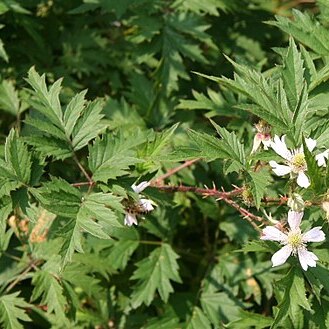Robust scrambling shrub; primocanes arching, greenish purple or purple, sharply angled and ± flat or concave between, with few to numerous subsessile glands, otherwise glabrous or sparsely clothed in simple and stellate hairs; armature of many, stout, ± falcate prickles on angles. Young stems sparsely to moderately hairy and glandular. Leaflets 5, sparsely pilose to glabrous on upper surface, sparsely to densely pilose on veins and sometimes also tomentose on lower surface, 1-2-pinnatisect to pinnate and pinnatisect, the segments remotely toothed; terminal leaflet lamina ovate-triangular, acuminate, 50-100 × 40-110 mm, with petiolule c. 1/2 length of lamina. Stipules linear. Infl. moderately hairy, with subsessile glands. Sepals attenuate, sometimes with longer expanded apex, usually toothed, tomentose and with longer simple hairs, with many pricklets. Petals rounded to acuminate, sometimes coarsely toothed, smooth, pale pink or white. Anthers glabrous.
A prickly trailing plant. It keeps growing from year to year. The leaflets are smaller than Rubus fruticosus and are almost triangle shaped. The leaflet at the end is usually the largest and is deeply lobed. There are teeth around these lobes. The fruit are black when ripe. Thornless kinds have been produced.

